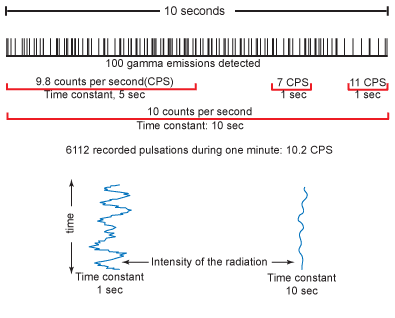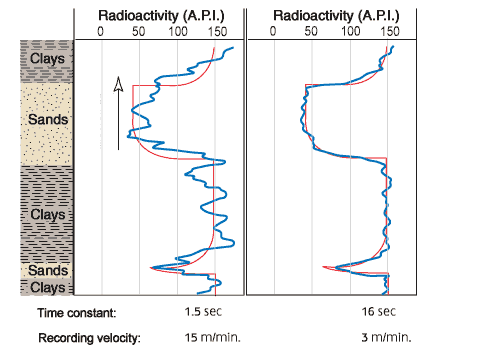Gamma Ray logs are recorded in different units:
- In oil logging the gamma is normally measured in API units (API=American Petroleum Institute). This unit is standardized: 16.5 API units corresponds to a concentration of radioactive elements equal to 1 microgram of radium per ton. The gamma ray probes used in oil logging give comparable responses from one probe to another because of their common calibration. Clays have an activity between 100 to 200 A.P.I., sands 30 to 80, limestone 10 to 50 API.
- In other fields, such as mining and in water prospecting, the units are only relative and rarely calibrated. The logs are recorded in counts per second, CPS, or counts per minutes, CPM. Each count corresponds to a detected incident gamma ray. Similar probes provide similar counts per second for a given rock type. The most common crystal size is 1" X 3", based on the limiting diameter of such probes. However, it can be difficult to compare the absolute values given by different tools.

![]() Time constant and statistic
Time constant and statistic
The number of API units or CPS for a given formation depends on the volume of the crystal, the electronics of the instrument, the recording method and the logging speed. In older analog recording systems, a resistor/capacitor network was used to "average" the random fluctuations of radioactive decay to provide a smoothed result that could be plotted by a chart recorder. In modern logging systems, each sample (whether derived by depth or time sampling) contains the total API units or CPS. These individual data samples are then averaged with PC programs to provide a smoothed output for presentation as a log. The raw data samples still contain the random radiation data, which is the true measurement. Geologists and engineers prefer to see the smoothed output, which minimizes the noisy (but real) appearance of radioactive logging tools. By convention, the value of the radioactivity increases towards the right on the log.

![]() Effect of the logging speed and the time constant.
Effect of the logging speed and the time constant.
It is impossible to predict how many atoms will decay and how many photons, for example, will be emitted in a short period of time.The measurement is done during a certain duration of time which is known as The Time Constant. T represents the time in seconds in which the average number of events measured is done. A large time constant tends to reduce the magnitude of fluctuations. Another important parameter is the logging speed. The choice of a large time constant will cause a delay in recording and induce shift on the curves in direction of the movement of the probe. We must therefore adjust the recording speed to the selected time constant. The logging speed will be the more slow since the selected time-constant will be large. The logging speed is generally so selected that the probe does not travel more than 30 cm during a time constant. This a good rule which allows to obtain quality Gamma Ray Log. For hydrogeological logs , this generally corresponds to speeds of less than 4m/min.